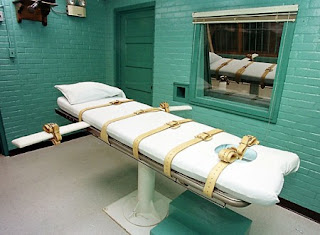 |
| Gas Chamber method of execution . . . |
“Man is but half a God,
he can take a life but
he cannot create one.”
Alex Hutchins circa the 60’s
Capital punishment, also called death penalty, execution of an offender sentenced to death after conviction by a court of law of a criminal offense. Capital punishment should be distinguished from extrajudicial executions carried out without due process of law. The term death penalty is sometimes used interchangeably with capital punishment, though imposition of the penalty is not always followed by execution (even when it is upheld on appeal), because of the possibility of commutation to life imprisonment.
According to the ACLU (American Civil Liberties Union), “the death penalty is discriminatory and arbitrary and inherently violates the Constitutional ban against cruel and unusual punishment.” The ACLU goes on to say that it “opposes the death penalty in all circumstances, and looks forward to the day when the United States joins the majority of nations that abolish it.”
 |
| Animal method of execution . . . |
Death Penalty Myths
Myth #1: The death penalty is not a deterrent to murder.
Myth #2: The death penalty is not reserved for the worst criminals regardless of their race or class.
Myth #3: Victims’ families do not all want the death penalty.
Myth #4: The Bible does not call for the death sentence when it says “an eye for an eye, tooth for a tooth.”
Myth #5: The death penalty costs more than life in prison.
Myth #6: Executions are not common throughout the world.
 |
| Electrocution method of execution . . . |
Global Methods of Execution
***Gas
***Hanging
***Shooting
***Execution methods used in US
I find it curiously interesting that while much has been written on the methods of execution and its pros and cons, very little has been written on the psychological state-of-mind of the executioner or its impact over time.
 |
| Firing squad method of execution . . . |
How easy or how difficult is it to watch
a man or a women being executed?
How easy or how difficult is it when it is you who has to flip the switch or push the button?
 |
| Guillotine method of execution . . . |
How does the executioner feel executing
another person year after year after year?
Could a religious person be an executioner or does it take an atheist?
 |
| Hanging method of execution . . . |
Is it easier to execute someone if you do not
have to watch the effects of what you are doing?
In the “ideal” Christian world, is taking another person’s life ever justified?
 |
| Draw and Quartering method of execution . . . |
I remember reading years ago a study that was conducted at one of our “leading” Universities where residents of the local town were collected and one-by-one put in rooms where they were asked to turn a knob that gave currents of electricity to a person in the adjoining room (who was an actor). Despite the cries of pain, the local resident would turn the knob to a lethal dose as long as the researcher was willing to take full responsibility for any injury to the electrocuted person in the adjoining room.
 |
| Crucifixion method of execution . . . |
Conclusion: Any average person, male or female, would reluctantly do what was done to the Jews in Nazi Germany as long as two conditions were satisfied:
- They did not have to witness the pain inflicted on the test subject
- Someone else was willing to take responsibility for their actions
But, what does this analogy have to do
with Capital Punishment in America anyway?
 |
| States with death penalty in tan . . . click to enlarge |


No comments:
Post a Comment